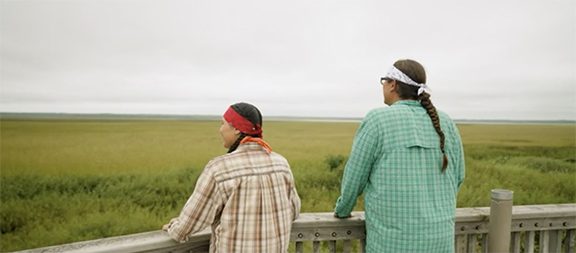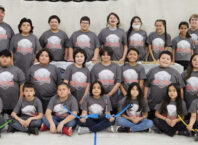Review by Deborah Locke
In the Public Broadcasting Service (PBS) Aug. 9, 2022 America Outdoors segment on northern Minnesota, you’ll see and hear single grains of wild rice fall into a canoe. The rhythmic sound of the pole knocking the rice from the stem is like a heartbeat, ba-boom, ba-boom, ba-boom.
It’s the best camera work I’ve ever seen of ricers at work, and it’s one of the best stories about the harvest that I’ve ever seen. Too bad the segment was so short. I could have listened to Veronica Skinaway (Sandy Lake) and Michaa Audid (East Lake) talk about the harvest and its meaning for the entire production.
The brief ricing segment is part of an hour-long show on the beauty and vulnerability of outdoors northern Minnesota. Several people devoted to preserving, sustaining and guaranteeing the future of the state’s wild areas are interviewed, including tree farmers, an artist, and a well-known birder from Duluth, Dudley Edmonson.
This is the sixth and final PBS show of the “America Outdoors With Baratunde Thurston” series which started in July. What PBS did especially well is show the remarkable, raw beauty of our state in regions not that easy to reach. The national PBS audience will be informed that views of the far north landscape and Lake Superior North Shore rival the sight of any mountains, canyons, deserts or plains in the U.S.
The aerial views make you catch your breath, even though all you’re watching is a screen. As Thurston walks the Superior Hiking Trail or stands near a waterfall or portages a canoe at the Boundary Waters Canoe Area, the instinct rises to go where he went and see what he saw for yourself.
That impulse may also be felt while watching the wild rice harvest. Skinaway and Audid, masters of the art of rice collection, made it look easy. For the uninitiated, know that it’s not easy, but participation in the harvest acts as an important historical and cultural touchstone for the Anishinaabe. Audid said that it takes maximum exertion to collect the rice, but the opportunity to rice is a labor of love. Skinaway pointed out the way an experienced ricer creates that hypnotic heartbeat rhythm as the rice falls from the stems. She said that there was no other food like it in the world, and that the rice is sacred.
“This is what saved the people,” she said, referring to the immigration of the Anishinaabe from the East Coast to the Midwest. The story is told that an Anishinaabe man had a dream about living in a place where food grew on the water, so the entire tribe began its long walk westward to Wisconsin and Minnesota where wild rice grew on the water. It’s what they found, as predicted, and it’s where they stayed.

My second favorite segment from the show explains why some people become hooked on “birding” – defined as the identification and observation of birds in their natural habitat. Dudley Edmonson from Duluth has spent more than 40 years in the wild areas of Minnesota, identifying and photographing birds.
He’s so good at it that he recognizes the birds from their call and can interpret from the call what the bird is trying to relay. A particular urgent chickadee bird call, for example, warns others that something is about to go down – a threat exists – so act. An African American, he has encountered people on camping trips who let him know that he is not welcomed in “their” public spaces, and call him the “N” word.”
“I will challenge people who challenge me,” he said, adding that two friends of his were fishing at a northern lake and someone on shore shot at them. The men were African American. In a later phone interview, Edmonson said his philosophy is simple. He believes that he belongs wherever he chooses to be. If someone tells him to go, he tells them to go, even if saying that puts him in harm’s way.
If you watch the show, there’s a lot to ponder. Consider the tiny tree saplings being planted now in northern forests, designed to replace the pine trees that are threatened by climate change. There’s the artist who uses natural elements and the sun to create art, and there’s the short takes from men and women who pipe up with reasons to love and protect the north woods.
Mostly the show gives the viewer vast amounts of Minnesota outdoors: blue water and sky, trees, sun, sounds. It’s worth watching.
The Minnesota production of “America Outdoors With Baratunde Thurston” airs at 8 p.m. on Aug. 9, 2022. This is the final show of the six-part series.







